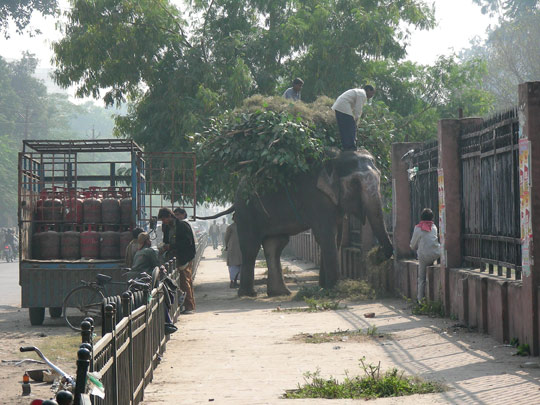
On December 6 we flew from New Delhi to the city of Lucknow, the capital of the state of Uttar Pradesh. Arranging the travel was vastly different than it would have been in 1998. In 1998 we would have had to book our flight through a travel agent. In 2005 we went online and purchased e-tickets through a secure airline website.
Indian airports are still so inefficient. So many personnel employed to do one more redundant check, and make one more ballpoint mark on my ticket. If as many Indians flew as Americans the whole infrastructure of airtravel would grind to a halt. Corporate America would revolt and develop Microsoft Airlines, General Motors Airlines, etc. Despite all that our flight was just delightful, and we could see the Himalaya Mountains to the north throughout a good part of the flight. We had the afternoon free to wander and wander we did in old Lucknow. Pam and I walked up to The Residency.
The Residency was built by one of the Nawabs for the British after the British East India Company defeated his forces in a battle. The post battle British peace treaty probably went something like this, “We won, Nawab you lost. We don’t trust you, so you will build us a very nice settlement for our Resident and his troops, close but not too close to your palace, so we can watch you very closely. Be alert for any orders we deem necessary for your continued comfort, and our continued profit for our shareholders.” The Siege of the Lucknow Residency was one of the most heavily contested battles of the 1857 Mutiny. From July to November 1857 the Indian troops, former sepoys in the British Army, laid siege to the Residency and its 2900 civilian men, women and children and soldiers. Mutineer cannon balls, cavalry charges, and infantry maneuvers took a tremendous toll. Reinforcing British troops drove off the mutineers/freedom fighters and relieved the siege in November. Only 900 survived the onslaught of iron, starvation and disease. The ruins were left undisturbed, and not until 1920 did British India take over the transformation of the battleground into a memorial/city park. After independence the Indian Government justly erected a monument to the Indian heroes who died trying to liberate their country from the yoke of British colonialism and exploitation. Likewise in America, we have many Revolutionary War battleground National Monuments such as Lexington Green, Valley Forge, and Yorktown. Just before we got to the entrance gate, I got smacked in the jaw by the tail of an elephant!! See above picture, find the tip of the tail. The sidewalk was wide enough to pass the elephant who was being loaded with the remains of a tree. I got so vigilant watching his hind legs for any movement that I forgot about the swinging tail. On the end of his tail the long hairs? were tied in a knot, whack. Guess, I’d rather the tail than a foot.
We walked south past the High Court Building. The thoroughfare was anything but a thoroughfare but rather a madhouse of people and vehicles. Court must have just adjourned for lunch. There were lawyers with long white starched collars and black suits, multiple varieties of police and constables, lunch wagons and street-side cookers, scooters and motorcycles bopping and weaving amongst the pedestrians, and fancy official cars flaunting their importance, and two obvious Americans just strolling along. It’s extremely hard to blend in if you have curly blond hair or wear a light blue LL Bean button-down collar dress shirt with khaki trousers! We had a leisurely lunch at a hotel and then took a taxi to the Aminabad Market. Another madhouse of humanity, but no necessary bargains were found. We hired a pedal rickshaw to take us back to CDRI.


